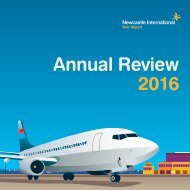Airport Masterplan 2035 LOW RES
You also want an ePaper? Increase the reach of your titles
YUMPU automatically turns print PDFs into web optimized ePapers that Google loves.
<strong>Masterplan</strong> <strong>2035</strong><br />
9. Surface Access<br />
Strategy<br />
9.1 Newcastle <strong>Airport</strong> is an essential part of the North East’s<br />
network of transport infrastructure, offering the national<br />
and international connections needed by the region. It is<br />
however both a generator of and destination for traffic for a<br />
range of transport modes. Every trip to the <strong>Airport</strong> starts and<br />
ends with a surface journey by private or public means, be<br />
it a passenger, staff member, supplier or freight shipment,<br />
or someone dropping off or picking up someone. These<br />
journeys can be very local, from within the region, or long<br />
distance from elsewhere in the country. Having reliable,<br />
efficient, and safe access to the <strong>Airport</strong> is critical for the<br />
current functioning of the <strong>Airport</strong>, but also supporting future<br />
growth. Without investment in surface transport infrastructure<br />
it will make other objectives for the <strong>Masterplan</strong> difficult to<br />
fulfil and potentially the <strong>Airport</strong>’s forecast growth not being<br />
achievable.<br />
9.2 The Surface Access Strategy looks at the current and future<br />
nature of travel to the <strong>Airport</strong>, opportunities for improvements,<br />
and potential constraints to this, both on and near the <strong>Airport</strong><br />
site, and throughout our catchment. We are also committed<br />
to improving the efficiency of travel on existing infrastructure,<br />
in particular through embracing of innovative technology to<br />
allow for ‘smart’ travel planning and journeys. The Surface<br />
Access Strategy is however deliberately high level in order<br />
to frame detailed initiatives at a later date, and so retain the<br />
flexibility required to respond to change.<br />
Policy Requirements<br />
9.3 The Aviation Development Framework (2013) requires that<br />
all airports have a Surface Access Strategy, which is also<br />
supported by Transport for the North. The plans are intended<br />
to show what development, alongside growth of an airport<br />
itself, is needed so that people and goods can continue to get<br />
to them easily and reliably. The strategies should -<br />
l Show how the proportion of journeys to and from the<br />
<strong>Airport</strong> by sustainable modes can be achieved and set<br />
targets for this change;<br />
l Demonstrate that the <strong>Airport</strong>’s growth can be achieved<br />
without causing undue adverse local impacts and<br />
congestion;<br />
l Set out what investments and actions are needed in the<br />
short and long term to achieve the strategy, both from<br />
partners and the <strong>Airport</strong>.<br />
9.4 The Strategy also helps to establish a plan for what may<br />
be required as and when a planning application is required<br />
to accommodate the <strong>Airport</strong>’s growth. Although we may<br />
be ultimately responsible for some local infrastructure<br />
improvements at that time, where the impact is predominantly<br />
from increase in movements associated with the <strong>Airport</strong><br />
growth, it also establishes where the benefits are likely to be<br />
shared and the costs burden shared or met by other means.<br />
48<br />
49




